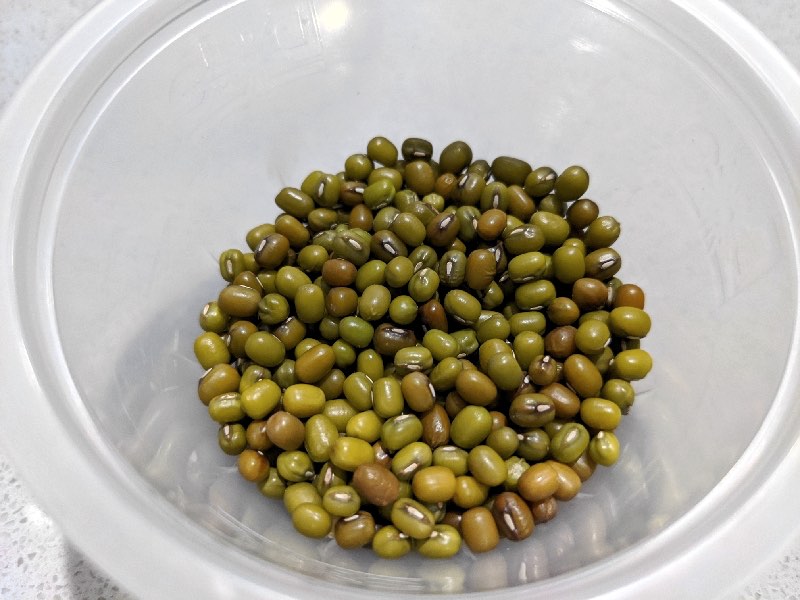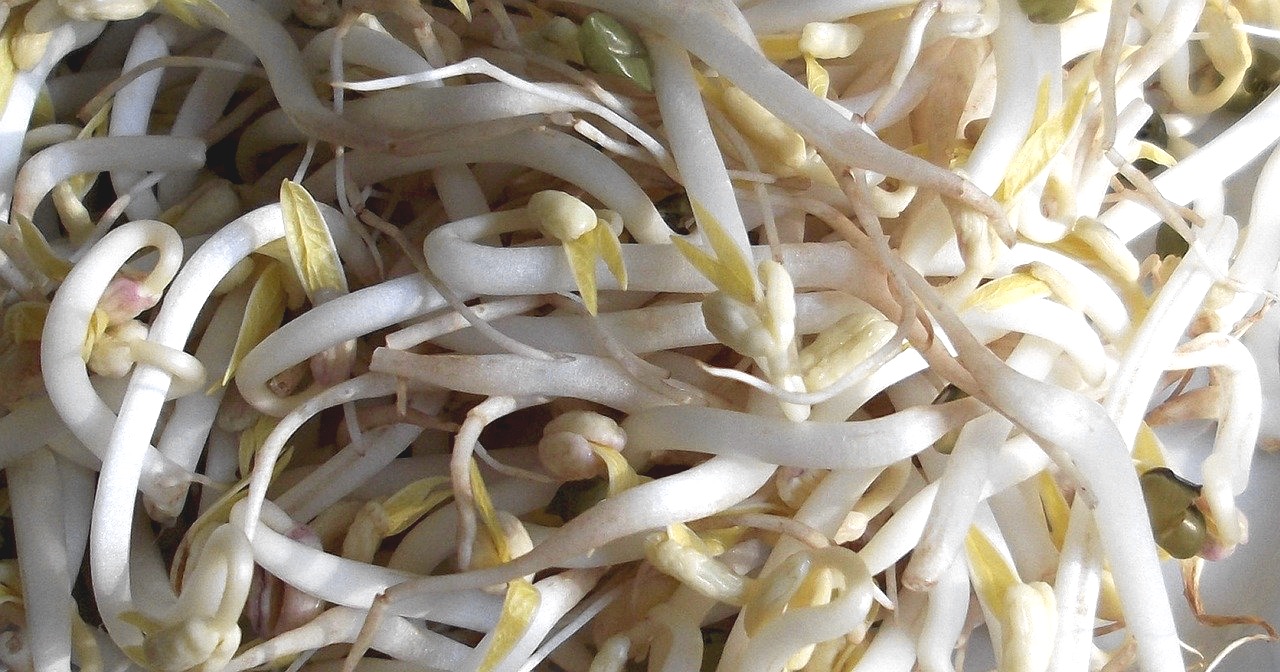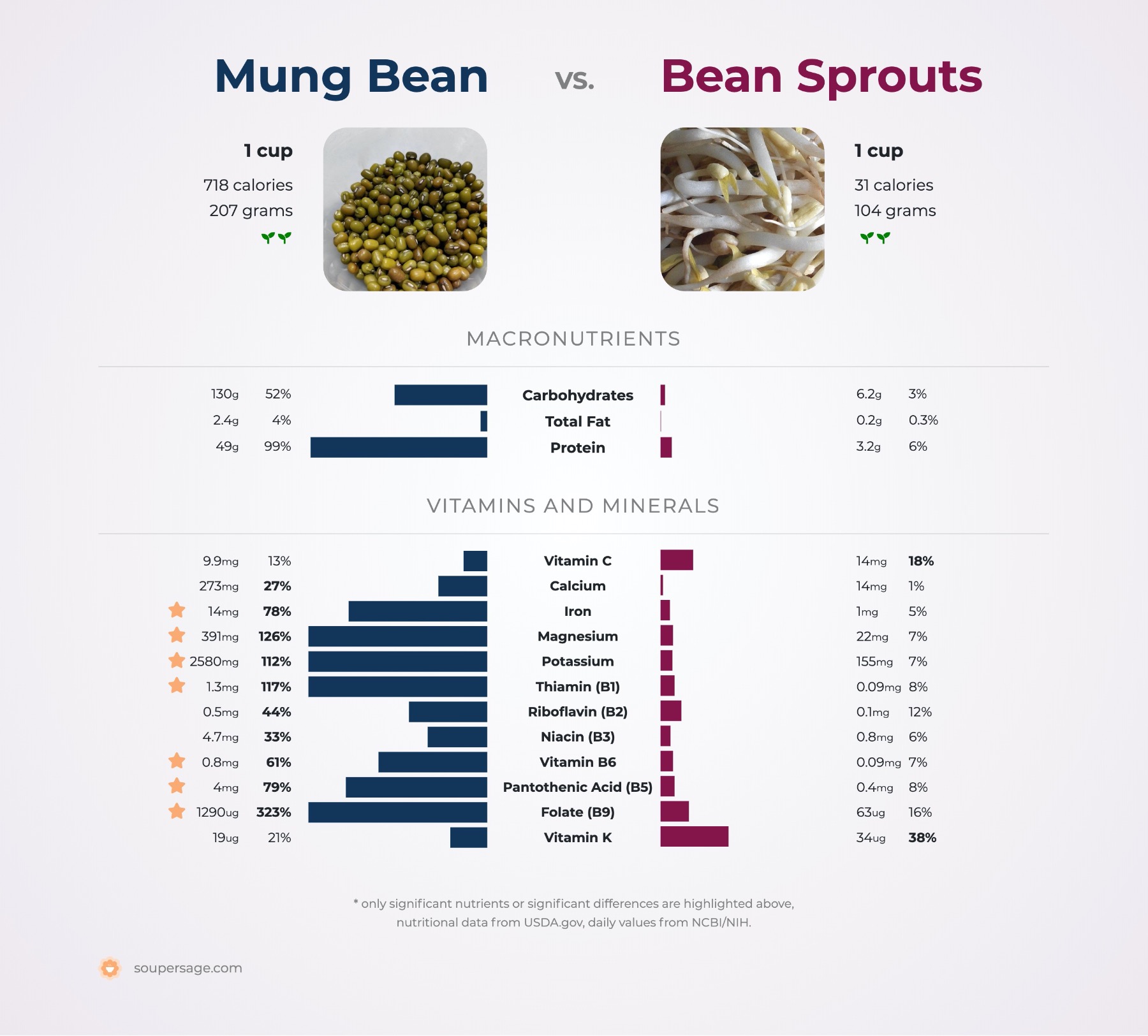Mung Bean vs. Bean Sprouts
Nutrition comparison of Mung Bean and Bean Sprouts
Ever wonder how your favorite beans or seeds and their sprouts stack up against each other in terms of nutrition? Does a single cooked bean or legume contain more protein? Or is its sprout full of dietary fiber?
We compared the nutritional contents of
mung bean
versus
bean sprouts
(100 beans or sprouts each)
below using 2020 USDA and NIH data[1].
For a quick recap of significant nutrients and differences in mung bean and bean sprouts:
- Bean sprout is a great source of Vitamin C.
- Mung bean has more thiamin, niacin, pantothenic acid, Vitamin B6 and folate.
- Mung bean is an excellent source of calcium, dietary fiber, iron, potassium and protein.
USDA sources for nutritional information: Mung Bean (Mung beans, mature seeds, raw) and Bean Sprouts (Mung beans, mature seeds, sprouted, raw) . Have a correction or suggestions? Shoot us an email.
Nutritional Information
The comparison below is comparing beans and sprouts for a dried or raw bean versus its sprouted or vegetable form. You can also see a more concrete comparison by weight at equal weight (by grams) comparison.
Note: The specific food items compared are: Mung Bean (Mung beans, mature seeds, raw) and Bean Sprouts (Mung beans, mature seeds, sprouted, raw) .
Mung Bean g
()
|
Daily Values (%) |
Bean Sprouts g
()
|
|||||
|---|---|---|---|---|---|---|---|
| KCAL % |
|
5% | calories | 5% |
|
KCAL % | |
| G % |
|
5% | carbohydrates | 5% |
|
G % | |
| G % |
|
5% | dietary fiber | 5% |
|
G % | |
| G | 5% | sugar | 5% | G | |||
| G % |
|
5% | total fat | 5% |
|
G % | |
| G % |
|
5% | saturated fat | 5% |
|
G % | |
| G | 5% | monounsaturated fat | 5% | G | |||
| G | 5% | polyunsaturated fat | 5% | G | |||
| G | 5% | trans fat | 5% | G | |||
| MG | 5% | cholesterol | 5% | MG | |||
| MG % |
|
5% | sodium | 5% |
|
MG % | |
| 5% | Vitamins and Minerals | 5% | |||||
| UG % |
|
5% | Vitamin A | 5% |
|
UG % | |
| MG % |
|
5% | Vitamin C | 5% |
|
MG % | |
| IU % |
|
5% | Vitamin D | 5% |
|
IU % | |
| MG % |
|
5% | calcium | 5% |
|
MG % | |
| MG % |
|
5% | iron | 5% |
|
MG % | |
| MG % |
|
5% | magnesium | 5% |
|
MG % | |
| MG % |
|
5% | potassium | 5% |
|
MG % | |
| MG % |
|
5% | thiamin (Vit B1) | 5% |
|
MG % | |
| MG % |
|
5% | riboflavin (Vit B2) | 5% |
|
MG % | |
| MG % |
|
5% | niacin (Vit B3) | 5% |
|
MG % | |
| MG % |
|
5% | Vitamin B6 | 5% |
|
MG % | |
| MG % |
|
5% | pantothenic acid (Vit B5) | 5% |
|
MG % | |
| UG % |
|
5% | folate (Vit B9) | 5% |
|
UG % | |
| UG % |
|
5% | Vitamin B12 | 5% |
|
UG % | |
| MG % |
|
5% | Vitamin E | 5% |
|
MG % | |
| UG % |
|
5% | Vitamin K | 5% |
|
UG % | |
| G % |
|
5% | protein | 5% |
|
G % | |
| UG % |
|
5% | biotin (Vit B7) | 5% |
|
UG % | |
| MG % |
|
5% | choline | 5% |
|
MG % | |
| MG % |
|
5% | chlorine | 5% |
|
MG % | |
| UG % |
|
5% | chromium | 5% |
|
UG % | |
| MG % |
|
5% | copper | 5% |
|
MG % | |
| UG % |
|
5% | fluoride | 5% |
|
UG % | |
| UG % |
|
5% | iodine | 5% |
|
UG % | |
| MG % |
|
5% | manganese | 5% |
|
MG % | |
| UG % |
|
5% | molybdenum | 5% |
|
UG % | |
| MG % |
|
5% | phosphorus | 5% |
|
MG % | |
| UG % |
|
5% | selenium | 5% |
|
UG % | |
| MG % |
|
5% | zinc | 5% |
|
MG % | |
| G | 5% | Water | 5% | G | |||
| G | 5% | Starch | 5% | G | |||
| G | 5% | Alcohol | 5% | G | |||
FAQ
Does bean sprouts or mung bean contain more calories in 100 grams?Mung bean is high in calories and bean sprout has 90% less calories than mung bean - bean sprout has 30 calories in 100g and mung bean has 347 calories.
Does bean sprouts or mung bean contain more calcium?
Mung bean is a rich source of calcium and it has 920% more calcium than bean sprout - bean sprout has 13mg of calcium in 100 grams and mung bean has 132mg of calcium.
Does bean sprouts or mung bean contain more iron?
Mung bean is an abundant source of iron and it has 640% more iron than bean sprout - bean sprout has 0.91mg of iron in 100 grams and mung bean has 6.7mg of iron.
Does bean sprouts or mung bean contain more potassium?
Mung bean is a rich source of potassium and it has 740% more potassium than bean sprout - bean sprout has 149mg of potassium in 100 grams and mung bean has 1246mg of potassium.


